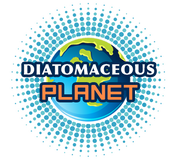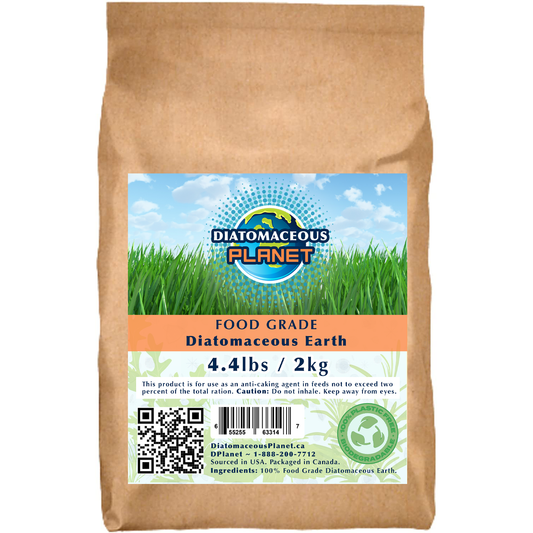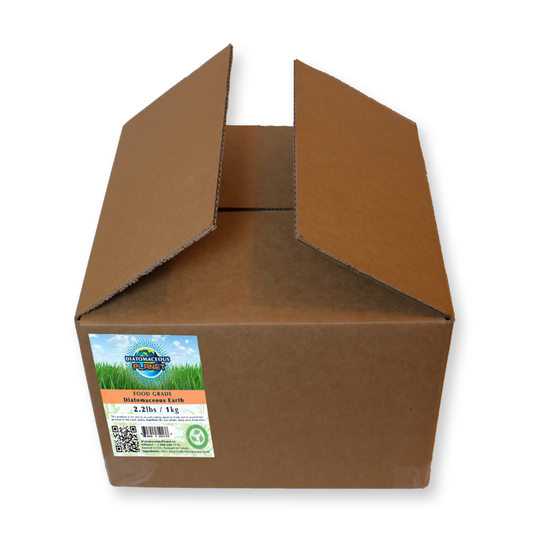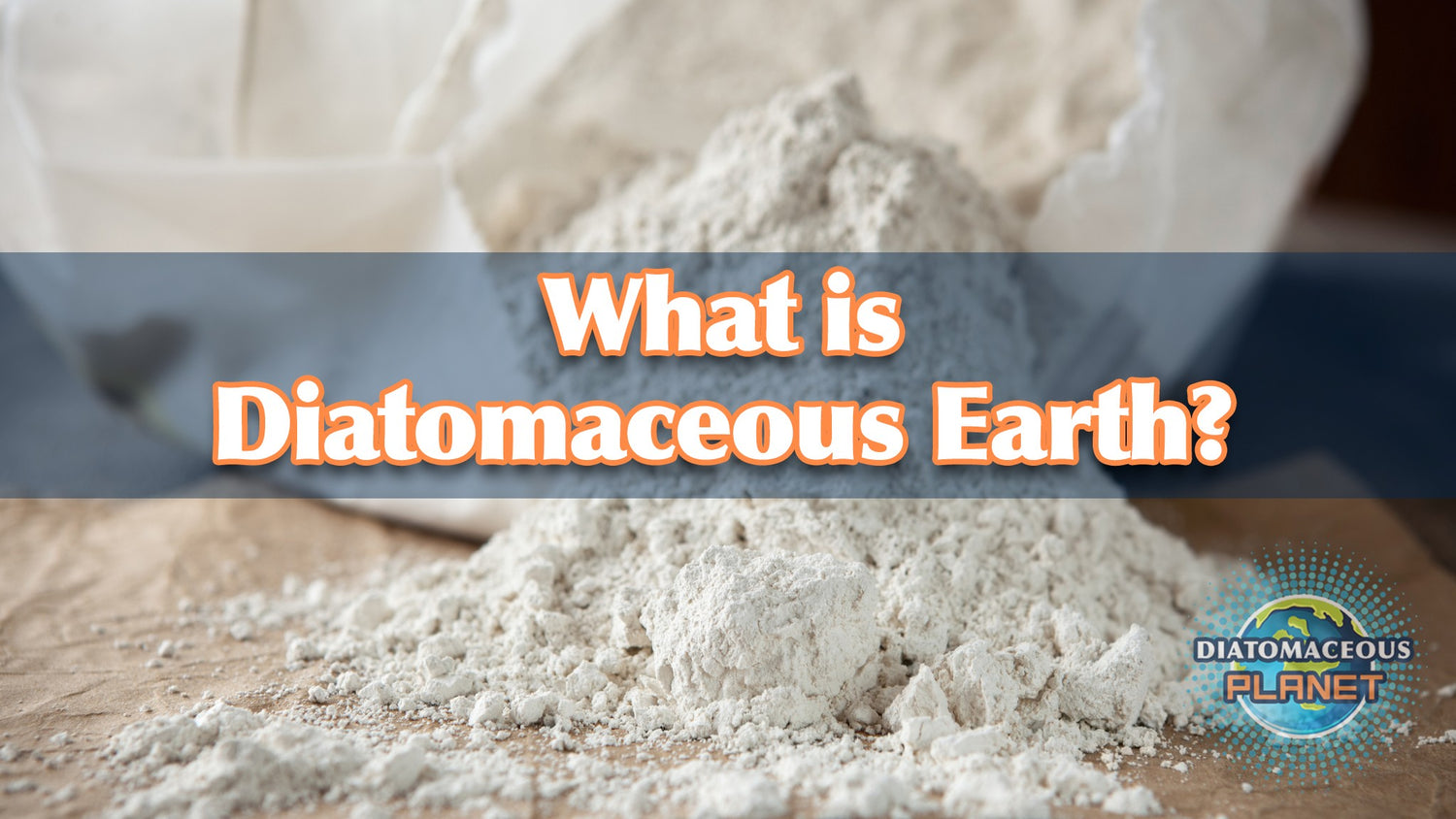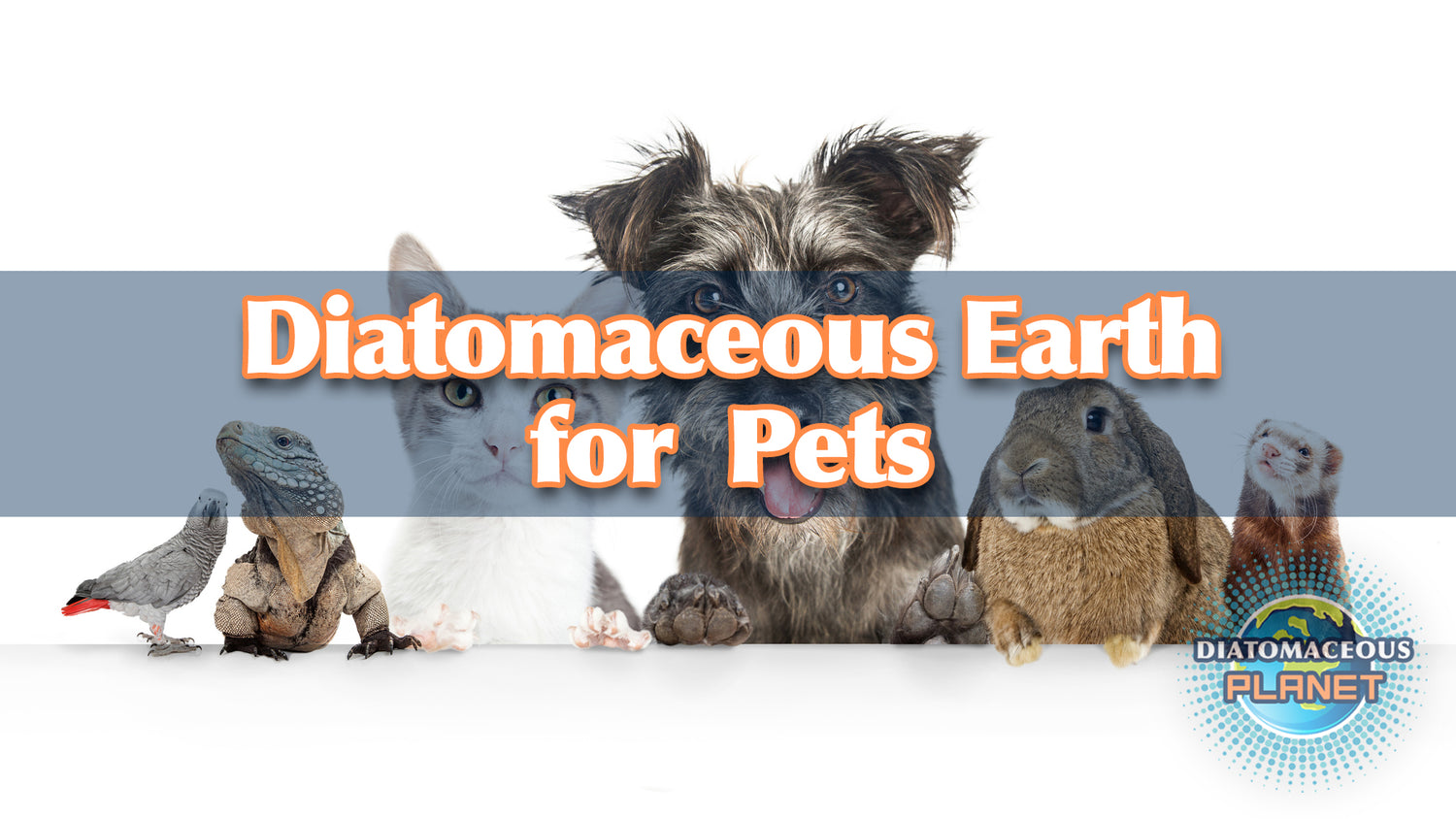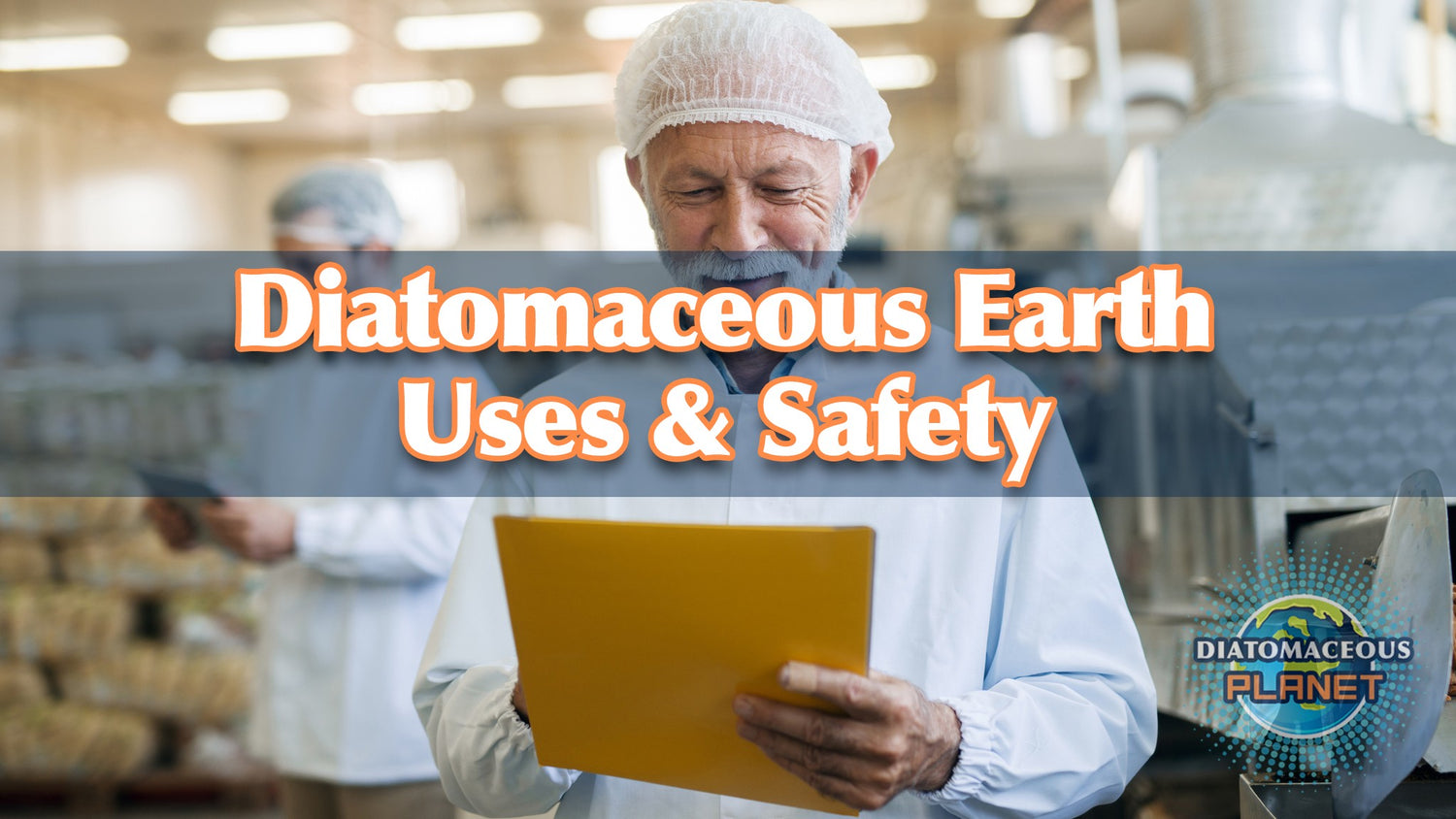Welcome to Diatomaceous Planet!
Diatomaceous earth (DE) is a naturally occurring, soft, sedimentary rock formed from the fossilized remains of diatoms, a type of microscopic algae. After the diatomite (raw DE) is collected, crushed, and refined; the final product is a silky, soft, off-white powder. There are many grades and forms of DE, depending on the intended use.
Food Grade Diatomaceous Earth (Food Grade DE) is the most commonly used kind of diatomite. Food Grade DE is uncalcined, which means it is a natural product; not altered or changed by heat or pressure treatments.
After the DE is purified and tested to meet food processing standards, it is then ready to be used as natural ingredient in a wide variety of food, beverage, personal, and even pet products!
Diatomaceous Earth available in Canada:
If you are shopping for top quality Food Grade Diatomaceous Earth in Canada, we have many product sizes instock , ready to order. We offer expedited $7.49 flat-rate shipping (Canada-wide), along with our friendly customer service to answer any questions you have about using our awesome product. Please take a look at our available options when you're ready to Buy Diatomaceous Earth.
-
Food Grade Diatomaceous Earth 1kg/2.2 lbs
Vendor:diatomaceousplanetRegular price $14.99 CADRegular priceUnit price per -
Food Grade Diatomaceous Earth 2kg/4.4 lbs
Vendor:diatomaceousplanetRegular price $21.99 CADRegular priceUnit price per$24.99 CADSale price $21.99 CADSale -
Case of Food Grade Diatomaceous Earth 1kg/2.2 lbs x7 (15 pounds)
Vendor:diatomaceousplanetRegular price $79.99 CADRegular priceUnit price per$94.99 CADSale price $79.99 CADSale -
Case of Food Grade Diatomaceous Earth 2kg/4.4 lbs x9 (40 Pounds)
Vendor:diatomaceousplanetRegular price $149.99 CADRegular priceUnit price per
Watch our Brand Video: Introducing Diatomaceous Planet...
What is Diatomaceous Earth?
Diatomaceous Earth is an all-natural product that can be used safely, and with many lasting benefits. The higher quality grade that is safe for all these uses. It is most commonly called Food Grade Diatomaceous Earth.
The appearance is typically a slightly off-white colour. As a substance, its texture is a very soft powder, nearly silky to the touch.
Having such a unique texture on a microscopic level is exactly what gives Food Grade DE it’s amazing effects in a wide variety of practical uses. The porous yet rock-hard composition is what makes a high quality Diatomaceous Earth the amazing product we all know and love...
If you would like to learn more about the science of what is DE, where does it come from, how is it made, and other questions about its composition, and versatile applications; please see our complete sections below.
- What is DE: How is it Made?
- Gardens and Farms
- Pet Care
- Personal Care
- Health and Wellness
- Food and Beverage Processing
- Industrial Uses
- Environmental Factors
- Common Misspellings
How Does DE form?
DE forms over long periods of time through the accumulation of the silica-rich cell walls, or frustules, of diatoms, a type of microscopic algae. When diatoms die, their frustules sink to the bottom of bodies of water and gradually accumulate as sediment. Over time, these accumulated frustules become compacted and cemented together, forming deposits of diatomaceous earth.
The formation of diatomaceous earth deposits is a slow process that can take thousands or even millions of years. Factors such as environmental conditions, sedimentation rates, and the abundance of diatom populations can influence the formation and composition of DE deposits. As layers of sediment accumulate and undergo geological processes such as compaction and lithification, they eventually solidify into the rock-like substance known as diatomaceous earth.
Diatomaceous Earth Composition
Before Diatomaceous Earth is mined and processed, it first exists as Algae. These algae patches are composed of single-celled plants called Diatoms. They represent the largest source of oxygen in the world. Diatoms are in nearly any ocean or freshwater lake.
Across the world there is a wide variety of variation, where each region has it’s own kind of diatom.
A diatom’s life relies on photosynthesis, just like any plant; collecting sunlight is essential. Living diatoms typically live on the surface of the ocean in large patches; this helps to maximize photosynthesis.
After the diatoms can feed on a steady light source, they then grow and multiply into new single cell organisms.
Another unique feature to diatoms, is their silica (siliceous) based cell-wall. This is very different from most plant-life, which has a carbon cell wall.
This feature is very important, as when the diatom is fossilized across time, it is the silica based skeleton that remains. When collected and refined, we have a beautiful soft and silky white powder that is nearly pure amorphous silica, called Diatomaceous Earth.
A good quality Food Grade DE will undergo a long manufacturing process including: mining, grinding and milling, purification, drying and finally packaging, for safe keeping.
Fossilized Diatoms
As we discussed above, Diatoms are originally living algae. They live as single celled plants that dwell on the surface of oceans and lakes to photosynthesis. So how do all these living diatoms transform into Diatomaceous Earth?
Over time the microscopic skeletons of diatoms are left behind, as a silica based shell. Imagine a huge lake from thousands of years ago, and every year the lake goes through its normal bloom cycles. That means that each year, another layer of diatom remains (shells) fall to the lake bed.
Layer upon layer accumulates, as each year and season passes. Over centuries and millennia, these remains collect to form underwater drifts of sediment. There are literally millions of tons of diatom shells (natural diatomaceous earth deposits) all over the world!
Let’s say a freshwater lake went through this process thousands of times, with trillions of diatoms. Over vast amounts of time, a deep reservoir of raw diatomite accumulates. The number of diatoms in one reservoir is actually impossible to calculate, the number would be so high!
Considering how many millions of years the Earth has been here, there sure are a lot of fossilized diatoms. Enough that many countries have DE mines, using it for a wide array of industrial applications.
Algae or Diatomite?
Not every reservoir of DE is pure, and not all forms come from freshwater sources either. In fact, many times the presence of fossilized diatoms is detectable, but mixed with other sediments to such a high degree that the source is not usable. That is why sourcing and researching your brand, before buying, is a worthy measure to practice.
For example, the presence of diatoms in sediment does not make it real Diatomaceous Earth.
The pure deposits called Diatomite, is where the best Food Grade Diatomaceous Earth is made. Again, it becomes more clear why the purity and quality of DE is so vitally important.
Our product is sourced from freshwater reservoirs, with a very high purity level. We are proud to offer the highest quality available, from North American sources.
Freshwater Reservoirs
All forms of Diatomaceous Earth are derived from special mining sites, which were ancient sea and lake beds. These aquatic environments were perfect for diatoms to proliferate.
Each location that DE is discovered is unique. Therefore, each deposit has a diatoms with a unique composition, making it a practical way to identify biological patterns in world regions.
It’s important to note as well that there are millions of tons of algae (diatoms) alive in all the oceans, seas, and lakes today. Just remember, living algae and phytoplankton is not diatomaceous earth, because it has not undergone a natural fossilization process.
Diatomite
The appearance of a diatomite mine is very interesting. You’ll see what appears to be a field of very fine white rock, with a crumbly appearance. It’s amazing to think how many thousands of years it would take to form just one of these freshwater reservoirs.
Once discovered, the mine’s diatom qualities and species are tested, and then further analysis can determine if there is a high quality product available for processing. Eventually, some of these locations become functioning Diatomite mines and reservoirs.
It’s important to note that not all diatomaceous earth is safe, and this has everything to do with which reservoir it has been mined from. For instance, there are many grades of diatomaceous earth which are mined from ancient sea beds (salt water), instead of ancient freshwater lake beds. Often the quality of salt water mined DE is unsafe, resulting in high levels of crystalline silica. Read more later in this article for important details about crystalline silica in Diatomaceous Earth products.
At Diatomaceous Planet, all our DE is Food Grade quality, and mined from a specific freshwater lake bed in the USA (Nevada Area). This mining location has yielded the highest quality product for many decades. Reliable applications range from agriculture, pets, personal, and industrial uses.
There are even charity organizations which create water filtration devices from this very same DE. We are proud and grateful to offer the highest quality to all our customers alike.
Diatomaceous Earth is Amorphous Silica
Many people have encountered silica or quartz, but what does it mean when silica is amorphous?
This information page is designed to clear up some common questions, and help you understand with more confidence what a good quality diatomaceous earth really is...
Often we find quartz rocks in gravel, or on beaches and waterfronts. The crystal form is easily recognizable; a recognizable sparkle or glitter in appearance. In geology, there are two types of quartz formations; massive and crystal. Massive quartz appears translucent, and is in all kinds of jagged shapes.
On the other hand, fully formed quartz crystals have six pronounced edges, and are ‘crystal’ clear (transparent) like pure glass.
But when do we find amorphous silica in such a natural form, instead of it being crystallized? A great example is limestone, and a resulting substance called calcite, which is common chalk powder.
Comparing Diatomaceous Earth and Chalk
Many people have used chalk at one time or another, however the chalk must first be processed from the limestone in order for it to become a usable product. Both quartz rocks (massive and crystals) and chalk are silica, but very different substances.
In the same way Diatomaceous Earth is another form of natural silica, derived from uniquely fossilized algae. The proper name for DE when it is being mined in rock form is Diatomite.
This pure and crumbly soft rock is crushed and collected, where later a separation process is included in order to refine and remove other sediments (usually feldspars, and basalt clays).
Once the basic drying and separation process is complete, a pure silky powder called Food Grade Diatomaceous Earth is the result.
What makes it Food Grade?
In order to be considered food grade, the manufacturer must guarantee that the level of crystalline silica is under 2%, where many DE reservoirs in USA are around 0.5%.
The crystalline form or “glass” form of silica is harmful to breathe, and ingest, where as amorphous is the rock-form, and serves to be much safer in all regards.
The uncalcined form, where the diatomaceous earth is mined naturally, is what we call ‘amorphous’ silica. All of our product is reliably in a natural and unaltered state for your personal safety.
We have Food Grade Diatomaceous Earth with crystalline silica levels at <0.01% (less than 0.0001). That is the lowest levels on the market.
Any of the risks or hazards associated with crystalline forms of silica, or any non-food grade products are eliminated by our supply chain’s manufacturing processes.
We have full assurance that our product is the safest Diatomaceous Earth around.
Choosing the right type of Diatomaceous Earth
Two very important factors to keep in mind when choosing the right kind of diatomaceous earth is the grade, and quality.
Firstly, it must be a Food Grade product, which means it is safe for ingestion, without many other internal hazards.
Secondly, the quality must be pure, in that the DE is not mixed with other additives or natural impurities. Our DE comes in at a whopping 89% (average) amorphous silica purity.
Along side our high purity, is the lowest level of crystalline silica, minimized at levels under 0.1% (0.001). Continue reading the next section to learn more details about Crystalline Silica in Diatomaceous Earth.
Crystalline Silica
When silica is in its glass form, we call it crystalline silica. The geological difference is based on the molecular structure. In order for a crystal to form, the molecules must be aligned properly.
Usually this takes place under an environment of intense heat or massive amounts of compression. Once under these conditions, the silica element will become a crystalline structure.
When is Crystalline DE used?
Even though the crystalline form of silica can be dangerous, it still has its uses. The most common product would be in pool filters, where the crystalline powder is contained in a vessel or compartment, protecting it from becoming airborne.
When waters are rinsed through the filter, the microscopic glass structures help to collect debris and unwanted microbes.
Our DE is Pure - Not Crystalline
Our product is not crystalline, and we are very happy to provide the safest food grade available. This means our DE product is natural.
It has not undergone any heat or pressure treatments that would alter the product to be unsafe (crystalline).
Our product has been tested as having the lowest crystalline silica content, of less than 0.1% (<0.001). We mentioned this statistic as well in the above paragraph in relationship to controlling and treating internal parasites.
We are happy to help with any questions, and are ready to connect you to a quality product with real results.
Diatomaceous Earth: The Science
Here we'll try to explore the best explanations possible about why DE is so effective, creating physical changes that amount to remarkable health benefits.
One very important fundamental about Food Grade Diatomaceous Earth, is the uniquely strong ionic charge. Because DE is made of nearly pure silica, it holds an elemental charge no matter what form.
Negative ionic charge
How does the negative ionic charge in Diatomaceous Earth make it more effective?
Diatomaceous Earth and Free Radicals
If you have heard of 'free radicals' or other forms of foreign particles that do harm in the body, then we are on track.
The body of living thing (mammals in this case) requires to also have a negative charge, where positively charged particles are typically a quality of unwanted microbes.
When the DE silica particles encounter these foreign positively charged particles, they are attracted and bind together.
Because our bodies digest only minimal amounts of amorphous silica, the rest is dispelled along with the toxins.
Essentially, the negative ionic charge is a fundamental quality of Diatomaceous Earth that makes it effective against many unhealthy encounters.
So how does the natural ionic charge in quartz rocks relate to Diatomaceous Earth?
Let's return to the fact that natural forms of diatomite are mostly made up of pure silica fossils. The silica is from the ancient layers of silica remains from living diatoms.
DE and Quartz
Does that mean Diatomaceous Earth particles carry an electric charge like quartz crystals? Yes, sort of... Offering the best possible example, we encourage you to look into what makes a modern clock tick (quartz).
There was a time when clocks and watches needed to be wound up with gears and springs. Often they would need to be fine tuned or reset, because the gears and springs were never really accurate enough to keep perfect time.
Suddenly, the common technology of how clockworks run (literally) quarts was used as the ideal component. It was discovered that a slight electrical stimulation (from a battery source) and the quartz will respond with a timely impulse.
This impulse is so steady and reliable, that the incremental ticking of a clock can revolve around it.
Diatomaceous Earth Safety and Precaution
The word siliceous (made of silica) is not very commonly used. However, when it comes to DE, it’s important that we understand its meaning.
Because DE is a very unique and natural form of silica, the different kinds of silica become even more important. Not all kinds of silica are alike, we can help explain some of the major differences right here...
Most commonly, people will see silica when it is used to eliminate moisture in clothing, or food products. These small packets of silica are usually less than a gram of tiny glass-like granules. Inside the packet is crystalline silica.
This form of silica is created by a process called calcination, which uses extreme temperatures and compression.
Crystalline silica can be very dangerous. Because it is a glass form of silica, the product is no longer safe for handling.
When Diatomaceous Earth is not a food grade, it is usually for specific industrial applications.
Please stay away from any DE products that do not clearly say Food Grade.
Not Food Grade?
Non food grade DE products have proven dangerous in many environments, especially when there is prolonged exposure. An example of a non-food grade DE product is a swimming pool filter.
We do not carry this kind of product, as we only provide the safest Food Grade quality. If you are an industrial company looking for other grades of DE.
The same as any food grade DE, the crystalline silica content is a special detail that should always be remembered when selecting a brand or product.
DE for Gardens, Farms, Homesteads
DE is used in gardens as a soil amendment to improve soil structure, drainage, and aeration. It helps break up heavy clay soils and increase water retention in sandy soils. DE also provides trace minerals such as silica, calcium, and magnesium, which can benefit plant growth and overall soil health.
Food Grade Diatomaceous Earth is also used as a supplement and additive for livestock and poultry to promote digestive health, control internal parasites, and reduce odors in barns and coops. When consumed, DE can help absorb toxins, improve nutrient absorption, and support overall digestive function in animals.
You can add Food Grade Diatomaceous Earth to your animal feed at a ratio of up to 2% (maximum).
Other livestock and farm animals that Food Grade DE is very effective and helpful to use as a feed additive includes: chickens, beef cattle, diary cattle, horses, goats, rabbits, turkeys, pigs, sheep, and other common forms of farm animals and livestock.
Pet Care
Diatomaceous Earth also is gaining popularity among pet owners for its effectiveness against parasites. Being able to control and eliminate parasites is a key factor in taking care of any pet. Typically, the Food Grade DE powder can be simply added to a pets daily food servings. By mixing the DE powder into a pets food you can help ensure your pet will consume a proper dose, and become free of parasite infections.
Food Grade DE can dramatically help dogs, cats, and small mammals (such as rodents and other housebound animals). It can also be very helpful with birds, reptiles, and amphibians, to keep their environment free of mites and other parasites.
DE is also helpful in reducing and eliminating odours in litterboxes, kennels, bedding, and koops. The unique frustule particle is extremely absorbent, and collects moisture, neutralizing odours to create a much more pleasant and hygeinic environment for pets and their owners alike.
Some small rodents such as chunchillas, hamsters, and guinie pigs enjoy dust bathing in Food Grade DE as a grooming instict, to help maintain cleanlieness and good hygeine. Our Diatomaceous Earth is safe for small rodents of all kinds.
Personal Care
Food grade diatomaceous earth is a versatile ingredient in personal care products, offering gentle exfoliation, oil absorption, detoxification, odor control, and other benefits for the skin, hair, and nails. Its natural origin and gentle nature make it a popular choice for those seeking effective yet gentle personal care solutions.
DE is being used in both wide-scale and artisan products to make soap, dry shampoos, deodorant, cosmetic clays, facial powders, scrubs, bathbombs, and other homemade and DIY products.
DE's absorbent properties make it effective for absorbing excess oils and sebum from the skin and scalp. It is used in oil-absorbing facial powders, dry shampoos, and oil-control masks to help mattify the skin and reduce shine, leaving the complexion looking fresh and matte.
As a mild abrasive agent in exfoliating scrubs, cleansers, and masks it can remove dead skin cells, unclog pores, and promote smoother, healthier-looking skin. Its fine particles gently slough away impurities and debris without causing irritation, making it suitable for sensitive skin types. It can be used on its own as a clay face mask, but is best blended with other clays (such as bentonite or kaolin).
Health and Wellness
When Food Grade DE is consumed as a dietary supplement, it can support detoxification processes in the digestive tract, and promote overall wellness. It is believed to absorb toxins, heavy metals, impurities, and excess waste in the intestines, helping to cleanse the digestive tract, and support healthy digestion.
Food Grade Diatomaceous Earth is also used to help reduce or eliminate parasite infections, including yeast and other commonly contracted parasite or fungal infections like pinworms, tapeworms, candida, ringworm and more.
Diatomaceous Earth is very high in silica, which is believed to support joint health by promoting the formation and maintenance of collagen and connective tissues. Consuming DE as a dietary supplement may help support bone density, strength, and overall bone health, with parallel joint health - promoting better function, flexibility, and mobility!
Silica in DE is beneficial for hair, skin, and nail health, as it helps promote collagen production and strengthen connective tissues resulting in improved appearance and overall strength of hair, skin, and nails.
Some people use DE as a dietary supplement to support weight management and appetite control. It is believed to help absorb fats and cholesterol in the digestive tract, promoting a feeling of fullness and reducing calorie absorption.
It's important to note that while food grade diatomaceous earth is generally considered safe for consumption, it's essential to consult with a healthcare professional before using it as a dietary supplement, especially if you have any underlying health conditions or are taking medications.
Food and Beverage Processing
Diatomaceous Earth is widely used as a filtration aid in food and beverage processing to remove impurities, solids, and suspended particles from liquids such as fruit juices, beer, wine, vegetable oils, and syrups. DE is also used as a clarifying agent to improve the clarity and transparency. It helps remove haze, sediment, and suspended solids from liquids, resulting in a cleaner and more aesthetically pleasing appearance.
Food Grade DE is commonly used in brewing and winemaking as a filtration aid and clarifying agent. It helps remove yeast, proteins, and other suspended particles from beer and wine, resulting in clearer and more stable products.
DE is added to powdered foods, spices, and seasonings as an anti-caking agent to prevent clumping and ensure uniform flowability. It helps maintain the texture and quality of dry food products by absorbing excess moisture and preventing the formation of lumps. The resulting dryness and flow prevents spoilage or causing rancidity in packaged foods.
In health food manufacturing, Food Grade Diatomaceous Earth can serve as a carrier for nutrients, and vitamins in supplements and other alternative food products. It helps evenly distribute these additives throughout the food matrix, ensuring uniformity and consistency in nutrient content.
Industrial Uses
Diatomaceous Earth may be used in pharmaceutical products as an excipient or inactive ingredient in tablet formulations, capsules, and topical medications. It can help improve the flowability of powders, act as a binding agent, or provide absorbent properties in certain formulations.
Food Grade DE can even be used in water treatment processes to remove impurities, sediment, and suspended solids from water. Grades of DE that are not food grade (calcined) can be used in filtration systems, pool filters, and wastewater treatment plants to enhance filtration efficiency and improve water quality.
Othere non-Food Grade forms of diatomaceous earth are utilized in various industrial applications, including abrasives, absorbents, insulation, and filtration media. It can be found in products such as cat litter, oil absorbents, paint additives, and insulation materials. These other grades of DE can also be used in construction materials such as paints, coatings, and sealants for its fire-retardant properties, absorbency, and texture-enhancing capabilities.
Both Food Grade DE and other grades demonstrate that Diatomite is a highly diverse and enhancing commodity, adding many layers of value to many industries world-wide!
Environmental Factors
The increasing demand for organic and natural products, coupled with a growing focus on sustainable agriculture, has fueled the popularity of food grade diatomaceous earth (DE).
As consumers prioritize eco-friendly alternatives, DE's natural, non-toxic, and eco-friendly properties make it an attractive choice in various applications.
Concerns about chemical residues in food have led to a search for safer alternatives, with DE emerging as a preferred option for food processing and packaging.
Regulatory support for natural products further boosts DE's acceptance and approval for use in food, beverage, and other industries.
Moreover, as people embrace sustainable living practices, DE's versatility and eco-friendly nature align well with their environmental goals.
Overall, a combination of consumer preferences, regulatory backing, and environmental consciousness drives the growing popularity of food grade DE across multiple sectors.
About Diatomaceous Planet
Thank you for learning about Diatomaceous Earth here on our brand homepage (Diatomaceous Planet by Novatree Labs), your trusted retail supplier in Food Grade Diatomaceous Earth.
Founded in 2021, we have been dedicated to bringing the best quality Food Grade Diatomaceous Earth into the end-user market. With a commitment to excellence and innovation, we strive to expand the availability and accessibility of pure food grade DE, along with reliable information.
At Diatomaceous Planet, we take pride in every package, that all our DE is held at the same quality standards. Our team of experts brings together years of experience and expertise to deliver a reliable, durable product; rapidly produced and distributed nation-wide for our clients/customers.
We take pride in our supply chain reliability, coupled with our high volume production capability. Whether it's high purity DE or well rounded expertise, we are here to serve your Food Grade DE needs.
Customer satisfaction is at the heart of everything we do. We prioritize customer satisfaction with a 30-day guarentee, along with flat-rate shipping options Canada-wide. Our goal is to be the best Food Grade Diatomaceous Earth retail product supplier in North America.
